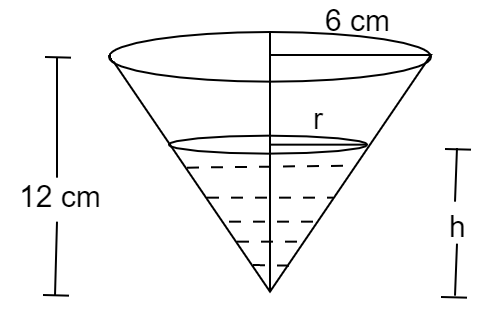
An inverted cone of height \[12{\text{ }}cm\] and base radius \[{\text{6 }}cm\] contains \[{\text{20 }}c{m^3}\] of water. Calculate the depth of water in the cone, measured from the vertex.
Answer
479.7k+ views
Hint: We will find the volume of the cone with height of \[12{\text{ }}cm\] and base radius \[{\text{6 }}cm\]using the formula i.e., \[{\text{Volume of a cone}} = \dfrac{1}{3} \times \pi \times {\left( {radius} \right)^2} \times \left( {height} \right)\]. Similarly, we will consider another cone which is formed due to water. We will calculate its volume by assuming its radius as \[r\] and height as \[h\]. As the volume of similar figures is in the same ratio as the ratio of the cube of their heights. So, using this and putting the given volume of cone formed by water i.e., \[{\text{20 }}c{m^3}\] we will find \[h\].
Complete step by step answer:

As we know, \[{\text{Volume of a cone}} = \dfrac{1}{3} \times \pi \times {\left( {radius} \right)^2} \times \left( {height} \right)\]
Consider the larger cone with height \[12{\text{ }}cm\] and base radius \[{\text{6 }}cm\].
\[ \Rightarrow {\text{Volume of the larger cone}} = \dfrac{1}{3} \times \pi \times {\left( 6 \right)^2} \times \left( {12} \right)\]
\[ = 144\pi \]
Consider the smaller cone, let its radius be \[r\] and height as \[h\].
Given, the cone contains \[{\text{20 }}c{m^3}\] of water. Therefore,
\[ \Rightarrow {\text{Volume of the smaller cone}} = 20{\text{ }}c{m^3}\]
As we know, the volume of similar figures is in the same ratio as the ratio of the cube of their heights. So, we can write
\[ \Rightarrow \dfrac{{{\text{Volume of the larger cone}}}}{{{\text{Volume of the smaller cone }}}} = \dfrac{{{{\left( {{\text{Height of the larger cone}}} \right)}^3}}}{{{{\left( {{\text{Height of the smaller cone}}} \right)}^3}}}\]
On putting the values, we get
\[ \Rightarrow \dfrac{{{\text{144}}\pi }}{{20{\text{ }}}} = \dfrac{{{{\left( {{\text{12}}} \right)}^3}}}{{{{\left( h \right)}^3}}}\]
On cross multiplication, we get
\[ \Rightarrow {\left( h \right)^3} = \dfrac{{20 \times {{\left( {{\text{12}}} \right)}^3}}}{{{\text{144}}\pi }}\]
On simplification we get
\[ \Rightarrow {\left( h \right)^3} = \dfrac{{20 \times {{\left( {{\text{12}}} \right)}}}}{{{\text{}}\pi }}\]
\[ \Rightarrow {h^3} = \dfrac{240}{\pi}\]
\[ \Rightarrow {h^3} = 76.39437\]
\[\therefore h = 4.243{\text{ }}cm\]
Therefore, the depth of water in the cone, measured from the vertex is \[4.243{\text{ }}cm\].
Note:
We have used the concept of similar figures, but one should keep in mind that two solids are similar if and only if they are the same type of solids and their corresponding linear measures such as radii, height, base, length, etc. are proportional. Students may get confused with the height of the cone and height of the empty part of the cone.
Complete step by step answer:

As we know, \[{\text{Volume of a cone}} = \dfrac{1}{3} \times \pi \times {\left( {radius} \right)^2} \times \left( {height} \right)\]
Consider the larger cone with height \[12{\text{ }}cm\] and base radius \[{\text{6 }}cm\].
\[ \Rightarrow {\text{Volume of the larger cone}} = \dfrac{1}{3} \times \pi \times {\left( 6 \right)^2} \times \left( {12} \right)\]
\[ = 144\pi \]
Consider the smaller cone, let its radius be \[r\] and height as \[h\].
Given, the cone contains \[{\text{20 }}c{m^3}\] of water. Therefore,
\[ \Rightarrow {\text{Volume of the smaller cone}} = 20{\text{ }}c{m^3}\]
As we know, the volume of similar figures is in the same ratio as the ratio of the cube of their heights. So, we can write
\[ \Rightarrow \dfrac{{{\text{Volume of the larger cone}}}}{{{\text{Volume of the smaller cone }}}} = \dfrac{{{{\left( {{\text{Height of the larger cone}}} \right)}^3}}}{{{{\left( {{\text{Height of the smaller cone}}} \right)}^3}}}\]
On putting the values, we get
\[ \Rightarrow \dfrac{{{\text{144}}\pi }}{{20{\text{ }}}} = \dfrac{{{{\left( {{\text{12}}} \right)}^3}}}{{{{\left( h \right)}^3}}}\]
On cross multiplication, we get
\[ \Rightarrow {\left( h \right)^3} = \dfrac{{20 \times {{\left( {{\text{12}}} \right)}^3}}}{{{\text{144}}\pi }}\]
On simplification we get
\[ \Rightarrow {\left( h \right)^3} = \dfrac{{20 \times {{\left( {{\text{12}}} \right)}}}}{{{\text{}}\pi }}\]
\[ \Rightarrow {h^3} = \dfrac{240}{\pi}\]
\[ \Rightarrow {h^3} = 76.39437\]
\[\therefore h = 4.243{\text{ }}cm\]
Therefore, the depth of water in the cone, measured from the vertex is \[4.243{\text{ }}cm\].
Note:
We have used the concept of similar figures, but one should keep in mind that two solids are similar if and only if they are the same type of solids and their corresponding linear measures such as radii, height, base, length, etc. are proportional. Students may get confused with the height of the cone and height of the empty part of the cone.
Recently Updated Pages
Two men on either side of the cliff 90m height observe class 10 maths CBSE

What happens to glucose which enters nephron along class 10 biology CBSE

Cutting of the Chinese melon means A The business and class 10 social science CBSE

Write a dialogue with at least ten utterances between class 10 english CBSE

Show an aquatic food chain using the following organisms class 10 biology CBSE

A circle is inscribed in an equilateral triangle and class 10 maths CBSE

Trending doubts
Why is there a time difference of about 5 hours between class 10 social science CBSE

Write a letter to the principal requesting him to grant class 10 english CBSE

What is the median of the first 10 natural numbers class 10 maths CBSE

The Equation xxx + 2 is Satisfied when x is Equal to Class 10 Maths

Which of the following does not have a fundamental class 10 physics CBSE

State and prove converse of BPT Basic Proportionality class 10 maths CBSE




